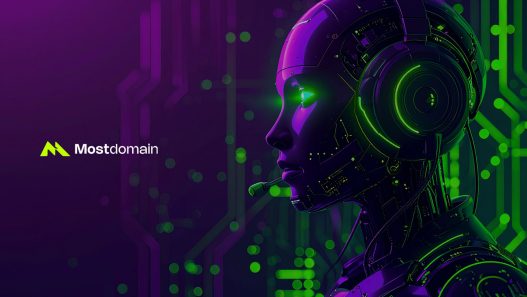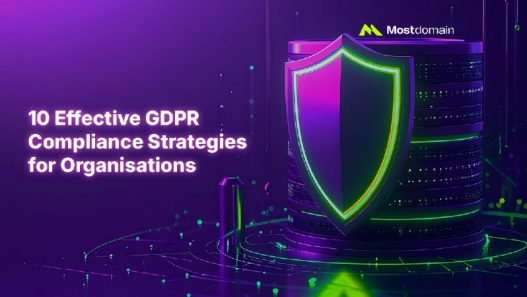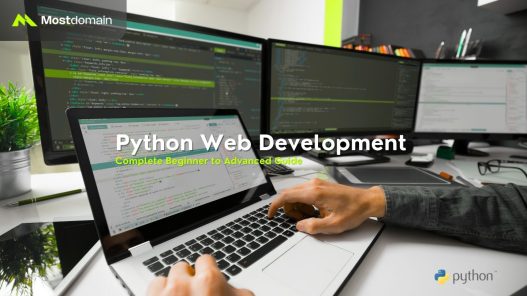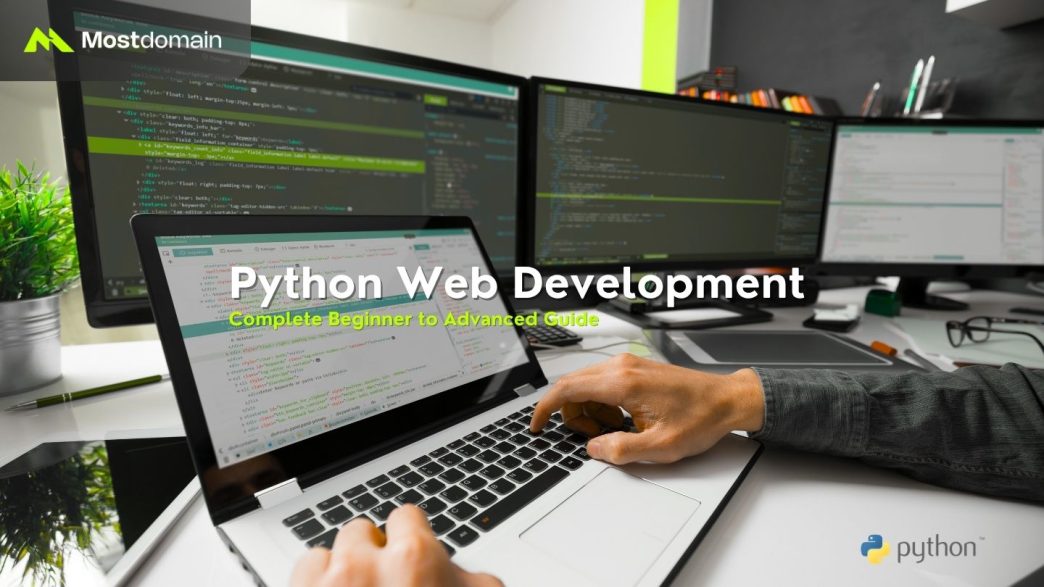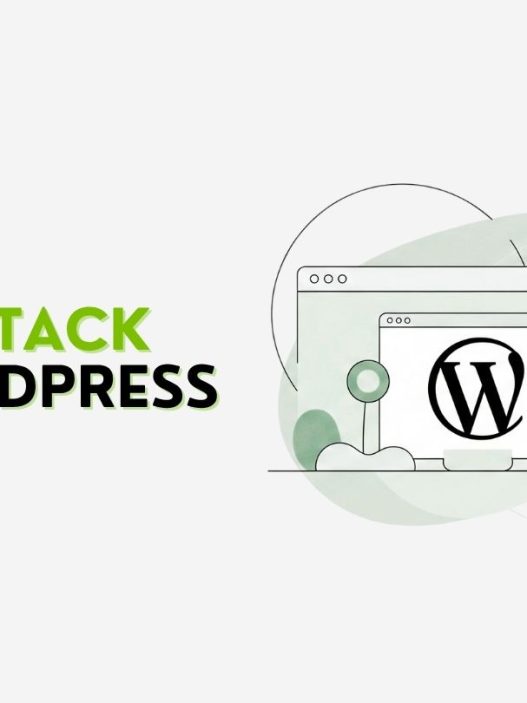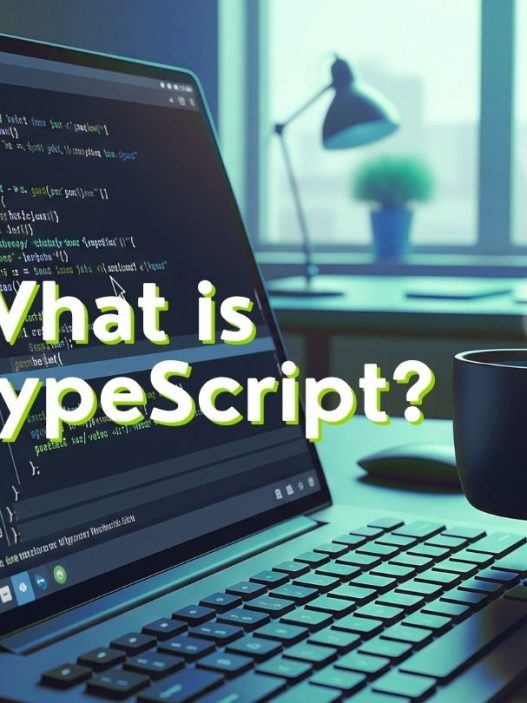Master the most in-demand programming skill that powers Instagram, Netflix, and thousands of modern web applications
Why Python Rules Web Development in 2025?
Python web development tutorial is your gateway to mastering one of the most versatile and powerful programming languages in 2025. Python has cemented its position as the undisputed champion of programming languages, maintaining its #1 spot in the TIOBE Index for 2025. But what makes this particularly exciting for aspiring web developers?
The statistics paint a compelling picture: 64% of startups using Python shipped their MVP within 12 weeks, significantly outperforming traditional enterprise stacks. Major platforms like Instagram, Reddit, and Netflix continue to scale millions of users with Python-powered backends.
Industry Insight: “Python’s clean syntax and powerful frameworks like Django and Flask make it the smartest choice for modern web applications, especially with the growing demand for AI-backed solutions.” – Stack Overflow Developer Survey 2025
Current Market Dominance
| Framework | Market Share | GitHub Stars | Job Demand |
| Django | 33% | 78k+ | High |
| Flask | 33% | 67k+ | High |
| FastAPI | 34% | 75k+ | Rapidly Growing |
The web development landscape has evolved dramatically, with Python frameworks now capturing equal market share. This distribution indicates a mature ecosystem where developers can choose the best tool for their specific needs.
Key advantages driving Python’s dominance:
- Rapid prototyping and development speed
- Extensive library ecosystem
- Strong community support
- Seamless AI/ML integration
- Enterprise-grade scalability
What Makes Python Perfect for Web Development?
Understanding Python’s core strengths helps explain why major corporations consistently choose it for mission-critical applications. The language’s design philosophy emphasizes code readability and developer productivity.
The Technical Edge: Python’s syntax allows developers to express complex concepts in fewer lines of code compared to Java or C++. This translates directly to faster development cycles and reduced maintenance costs.
Python vs Other Languages for Web Development
# Python – Clean and readable
def calculate_user_score(user_data):
return sum(score for score in user_data.values())
# Equivalent Java – More verbose
public int calculateUserScore(Map<String, Integer> userData) {
return userData.values().stream()
.mapToInt(Integer::intValue)
.sum();
}
The “batteries included” philosophy means Python comes with a comprehensive standard library. Web developers can access modules for everything from HTTP handling to database connections without external dependencies.
Framework Ecosystem Strength
Python’s web framework ecosystem offers solutions for every project scale:
- Micro-frameworks: Flask for lightweight applications
- Full-stack frameworks: Django for rapid enterprise development
- Modern async frameworks: FastAPI for high-performance APIs
- Specialized frameworks: Tornado for real-time applications
Developer Satisfaction: Python consistently ranks in the top 3 most loved programming languages, with 87% of developers expressing satisfaction with the language.
Django vs Flask vs FastAPI: Which Framework Should You Choose?
The eternal question facing every Python web developer: which framework should you learn first? The answer depends on your project requirements, experience level, and long-term goals.
Django: The Full-Stack Powerhouse
Django follows the “convention over configuration” principle, providing everything needed to build complex web applications out of the box. It’s particularly suited for content-heavy sites and applications requiring rapid development.
When to choose Django:
- Building content management systems
- Developing e-commerce platforms
- Creating admin-heavy applications
- Need for built-in authentication and authorization
Django’s killer features:
- Automatic admin interface
- Built-in ORM with migration system
- Robust security features
- Scalable architecture
Flask: The Flexible Micro-Framework
Flask takes a minimalist approach, giving developers complete control over their application architecture. It’s perfect for developers who prefer to choose their own components and build custom solutions.
When to choose Flask:
- Building APIs and microservices
- Creating prototypes quickly
- Learning web development fundamentals
- Need maximum flexibility
Flask’s advantages:
- Lightweight and fast
- Extensive customization options
- Easy to understand and debug
- Large ecosystem of extensions
FastAPI: The Modern Speed Champion
FastAPI represents the cutting edge of Python web development, combining modern Python features with exceptional performance. It’s designed specifically for building APIs with automatic documentation generation.
When to choose FastAPI:
- Building high-performance APIs
- Creating microservices architecture
- Need automatic API documentation
- Working with modern Python features (type hints)
Framework Comparison Matrix
| Feature | Django | Flask | FastAPI |
| Learning Curve | Moderate | Easy | Moderate |
| Performance | Good | Good | Excellent |
| Documentation | Excellent | Good | Excellent |
| Community Size | Large | Large | Growing |
| Job Market | High | High | Emerging |
| Best For | Full websites | Flexibility | APIs |
How to Set Up Your Python Web Development Environment?
Setting up a proper development environment is crucial for productive Python web development. A well-configured environment saves countless hours of debugging and ensures consistency across different machines.
Essential Tools Installation
Step 1: Python Installation Download Python 3.11+ from the official website. Ensure you check “Add Python to PATH” during installation on Windows systems.
# Verify installation
python –version
pip –version
Step 2: Virtual Environment Setup Virtual environments prevent package conflicts and maintain project isolation:
# Create virtual environment
python -m venv webdev_env
# Activate environment (Windows)
webdev_env\Scripts\activate
# Activate environment (Mac/Linux)
source webdev_env/bin/activate
Development Tools Checklist
| Tool | Purpose | Installation |
| VS Code | Code editor | Download from official site |
| Git | Version control | git –version to check |
| Postman | API testing | Download desktop app |
| PostgreSQL | Database | Download installer |
Essential VS Code Extensions:
- Python Extension Pack
- GitLens
- Thunder Client
- Python Docstring Generator
Database Configuration
Most web applications require a database. Here’s how to set up PostgreSQL, the preferred choice for production Django applications:
— Create development database
CREATE DATABASE webdev_tutorial;
CREATE USER webdev_user WITH PASSWORD ‘secure_password’;
GRANT ALL PRIVILEGES ON DATABASE webdev_tutorial TO webdev_user;
Security Note: Never use default passwords in production environments. Always use environment variables for sensitive configuration.
Building Your First Flask Web Application
Flask’s simplicity makes it perfect for understanding web development fundamentals. We’ll build a practical todo application that demonstrates core concepts every web developer needs to master.
Project Structure Setup
todo_app/
├── app.py
├── templates/
│ ├── base.html
│ ├── index.html
│ └── add_task.html
├── static/
│ ├── css/
│ └── js/
└── requirements.txt
Creating the Basic Flask Application
# app.py
from flask import Flask, render_template, request, redirect, url_for
from datetime import datetime
app = Flask(__name__)
# In-memory storage for simplicity
tasks = []
@app.route(‘/’)
def index():
return render_template(‘index.html’, tasks=tasks)
@app.route(‘/add’, methods=[‘GET’, ‘POST’])
def add_task():
if request.method == ‘POST’:
task = {
‘id’: len(tasks) + 1,
‘title’: request.form[‘title’],
‘description’: request.form[‘description’],
‘created_at’: datetime.now().strftime(‘%Y-%m-%d %H:%M’)
}
tasks.append(task)
return redirect(url_for(‘index’))
return render_template(‘add_task.html’)
if __name__ == ‘__main__’:
app.run(debug=True)
Understanding Flask Routing
Flask uses decorators to map URLs to functions. This elegant approach makes it easy to understand how requests flow through your application:
- @app.route(‘/’) – Handles the home page
- @app.route(‘/add’, methods=[‘GET’, ‘POST’]) – Handles both displaying and processing forms
Template Integration: Flask uses Jinja2 templating engine, which allows you to create dynamic HTML pages with Python-like syntax.
<!– templates/index.html –>
{% extends “base.html” %}
{% block content %}
<h1>My Todo List</h1>
{% for task in tasks %}
<div class=”task-card”>
<h3>{{ task.title }}</h3>
<p>{{ task.description }}</p>
<small>Created: {{ task.created_at }}</small>
</div>
{% endfor %}
<a href=”{{ url_for(‘add_task’) }}” class=”btn”>Add New Task</a>
{% endblock %}
Running Your Flask Application
# Install Flask
pip install flask
# Run the application
python app.py
Your application will be available at http://localhost:5000. The debug mode enables automatic reloading when you modify your code.
Creating a Complete Django Project Step-by-Step
Django’s “batteries included” approach provides a robust foundation for building scalable web applications. We’ll create a blog application that showcases Django’s powerful features.
Why Start with a Blog Application?
Blog applications demonstrate essential web development concepts: user authentication, content management, database relationships, and admin interfaces. These skills transfer directly to more complex projects.
Django Project Initialization
# Install Django
pip install django
# Create project
django-admin startproject blog_project
cd blog_project
# Create app
python manage.py startapp blog
# Run migrations
python manage.py migrate
# Create superuser
python manage.py createsuperuser
Models: Defining Your Data Structure
# blog/models.py
from django.db import models
from django.contrib.auth.models import User
from django.urls import reverse
class Post(models.Model):
title = models.CharField(max_length=200)
slug = models.SlugField(unique=True)
author = models.ForeignKey(User, on_delete=models.CASCADE)
content = models.TextField()
created_at = models.DateTimeField(auto_now_add=True)
updated_at = models.DateTimeField(auto_now=True)
published = models.BooleanField(default=False)
class Meta:
ordering = [‘-created_at’]
def __str__(self):
return self.title
def get_absolute_url(self):
return reverse(‘blog:post_detail’, args=[self.slug])
Views: Handling Business Logic
Django supports both function-based and class-based views. Class-based views provide more functionality with less code:
# blog/views.py
from django.views.generic import ListView, DetailView
from django.shortcuts import render
from .models import Post
class PostListView(ListView):
model = Post
template_name = ‘blog/post_list.html’
context_object_name = ‘posts’
paginate_by = 5
def get_queryset(self):
return Post.objects.filter(published=True)
class PostDetailView(DetailView):
model = Post
template_name = ‘blog/post_detail.html’
context_object_name = ‘post’
Django’s Admin Interface
One of Django’s standout features is the automatic admin interface:
# blog/admin.py
from django.contrib import admin
from .models import Post
@admin.register(Post)
class PostAdmin(admin.ModelAdmin):
list_display = [‘title’, ‘author’, ‘created_at’, ‘published’]
list_filter = [‘published’, ‘created_at’, ‘author’]
search_fields = [‘title’, ‘content’]
prepopulated_fields = {‘slug’: (‘title’,)}
date_hierarchy = ‘created_at’
URL Configuration
# blog/urls.py
from django.urls import path
from . import views
app_name = ‘blog’
urlpatterns = [
path(”, views.PostListView.as_view(), name=’post_list’),
path(‘<slug:slug>/’, views.PostDetailView.as_view(), name=’post_detail’),
]
Pro Tip: Django’s URL patterns use named groups, making it easy to create SEO-friendly URLs with meaningful slugs instead of database IDs.
What Are the Advanced Web Development Concepts You Need?
Mastering basic framework usage is just the beginning. Professional web development requires understanding several advanced concepts that separate junior developers from senior practitioners.
Database Design and Optimization
Efficient database design significantly impacts application performance. Understanding relationships, indexing, and query optimization becomes crucial as your application scales.
Key database concepts:
- Foreign Keys: Establishing relationships between models
- Many-to-Many: Handling complex relationships
- Database Indexing: Improving query performance
- Query Optimization: Using select_related() and prefetch_related()
# Inefficient – N+1 query problem
posts = Post.objects.all()
for post in posts:
print(post.author.username) # Additional query for each post
# Optimized – Single query with join
posts = Post.objects.select_related(‘author’)
for post in posts:
print(post.author.username) # No additional queries
RESTful API Development
Modern web applications often separate frontend and backend concerns. Understanding REST principles enables you to build APIs that integrate with mobile apps, SPAs, and third-party services.
REST API Design Principles:
- Use HTTP methods semantically (GET, POST, PUT, DELETE)
- Implement proper status codes
- Design intuitive URL structures
- Provide consistent response formats
Authentication and Security
Security considerations must be built into applications from the ground up, not added as an afterthought.
Essential security practices:
- CSRF Protection: Preventing cross-site request forgery
- SQL Injection Prevention: Using parameterized queries
- XSS Protection: Sanitizing user input
- Authentication Systems: Implementing secure login mechanisms
| Security Feature | Django | Flask |
| CSRF Protection | Built-in | Extension required |
| SQL Injection | ORM protection | ORM dependent |
| XSS Protection | Auto-escaping | Manual implementation |
| Session Security | Secure defaults | Manual configuration |
Caching Strategies
Implementing caching dramatically improves application performance by reducing database queries and computational overhead.
Caching levels:
- Browser caching: Static assets
- Template caching: Rendered HTML
- Database caching: Query results
- Application caching: Computed values
# Django caching example
from django.core.cache import cache
def expensive_function(user_id):
cache_key = f’user_data_{user_id}’
result = cache.get(cache_key)
if result is None:
# Expensive computation here
result = perform_complex_calculation(user_id)
cache.set(cache_key, result, 300) # Cache for 5 minutes
return result
How to Deploy Your Python Web Application?
Deployment transforms your local development project into a live application accessible to users worldwide. Understanding deployment options and best practices is essential for any web developer.
Choosing the Right Hosting Platform
Different platforms offer varying levels of control, cost, and complexity. Your choice depends on project requirements, budget, and technical expertise.
Platform Comparison:
| Platform | Complexity | Cost | Best For |
| Heroku | Low | Medium | Beginners, MVPs |
| DigitalOcean | Medium | Low | Growing applications |
| AWS | High | Variable | Enterprise applications |
| Railway | Low | Low | Modern alternatives |
Heroku Deployment Step-by-Step
Heroku simplifies deployment with git-based deployments and automatic scaling capabilities.
Preparation steps:
- Create requirements.txt file
- Add Procfile for process configuration
- Configure environment variables
- Set up database connections
# Generate requirements.txt
pip freeze > requirements.txt
# Create Procfile
echo “web: gunicorn app:app” > Procfile
# Install Heroku CLI and deploy
heroku create your-app-name
git push heroku main
Environment Configuration
Professional applications separate configuration from code using environment variables:
import os
from dotenv import load_dotenv
load_dotenv()
class Config:
SECRET_KEY = os.environ.get(‘SECRET_KEY’) or ‘dev-secret-key’
DATABASE_URL = os.environ.get(‘DATABASE_URL’) or ‘sqlite:///app.db’
DEBUG = os.environ.get(‘DEBUG’, ‘False’).lower() == ‘true’
Production Considerations
Essential production setup:
- Use production-grade web servers (Gunicorn, uWSGI)
- Implement proper logging
- Set up monitoring and error tracking
- Configure SSL certificates
- Optimize static file serving
Critical: Never deploy with DEBUG=True in production. This exposes sensitive information and creates security vulnerabilities.
What Career Opportunities Await Python Web Developers?
Python web development skills open doors to diverse career paths in today’s technology-driven economy. Understanding the job market helps you focus your learning efforts on high-demand skills.
Current Job Market Analysis
The demand for Python developers continues outpacing supply, creating excellent opportunities for both entry-level and experienced professionals.
Salary ranges by experience level:
- Junior Developer (0-2 years): $65,000 – $85,000
- Mid-level Developer (2-5 years): $85,000 – $120,000
- Senior Developer (5+ years): $120,000 – $180,000
- Tech Lead/Architect: $150,000 – $250,000+
Career Path Options
Traditional web development roles:
- Full-stack Developer
- Backend Developer
- DevOps Engineer
- Technical Lead
Emerging opportunities:
- AI/ML Engineer with web skills
- Data Engineering roles
- Cloud Solutions Architect
- Product Manager (technical)
Skills That Command Premium Salaries
| Skill Category | High-Demand Technologies | Salary Impact |
| Cloud Platforms | AWS, GCP, Azure | +15-25% |
| DevOps Tools | Docker, Kubernetes | +20-30% |
| AI/ML Integration | TensorFlow, PyTorch | +25-40% |
| Microservices | FastAPI, GraphQL | +15-20% |
Building Your Professional Portfolio
A strong portfolio demonstrates practical skills to potential employers:
Essential portfolio projects:
- Full-stack web application with user authentication
- RESTful API with comprehensive documentation
- Data visualization dashboard showcasing analytical skills
- Deployed application demonstrating DevOps capabilities
Career Tip: Contributing to open-source projects significantly enhances your visibility and demonstrates collaboration skills valued by employers.
Your Next Steps to Mastery
Becoming proficient in Python web development requires consistent practice and continuous learning. The technology landscape evolves rapidly, making lifelong learning essential for career success.
Recommended Learning Path
Phase 1: Foundation Building (2-3 months)
- Master Python fundamentals
- Complete Flask tutorial projects
- Understand HTTP and web protocols
- Learn basic HTML/CSS/JavaScript
Phase 2: Framework Mastery (3-4 months)
- Deep dive into Django or Flask
- Build complete web applications
- Implement user authentication
- Deploy applications to production
Phase 3: Advanced Concepts (4-6 months)
- Learn API development (REST/GraphQL)
- Understand database design principles
- Implement caching and optimization
- Explore testing methodologies
Phase 4: Specialization (Ongoing)
- Choose focus area (AI integration, microservices, etc.)
- Contribute to open-source projects
- Stay current with emerging technologies
- Build professional network
Essential Resources for Continued Learning
Official Documentation:
- Python.org tutorials and guides
- Django documentation
- Flask documentation
- Framework-specific best practices
Community Resources:
- Stack Overflow for problem-solving
- Reddit communities (r/Python, r/django)
- Python Discord servers
- Local Python meetups and conferences
Advanced Learning Platforms:
- Real Python for in-depth tutorials
- Pluralsight for structured courses
- GitHub for open-source contributions
- YouTube for video tutorials
Building Your Professional Network
Networking accelerates career growth and provides opportunities for collaboration and mentorship:
Networking strategies:
- Attend Python conferences and meetups
- Participate in online communities
- Contribute to open-source projects
- Share knowledge through blogging or talks
- Connect with developers on LinkedIn
Success Mindset: Treat every project as a learning opportunity. The field evolves constantly, and adaptability is your greatest asset.
Final Thoughts: Your Journey Starts Now
Python web development offers an extraordinary combination of accessibility for beginners and power for advanced applications. The frameworks and concepts covered in this guide provide a solid foundation for building modern web applications that scale.
The technology industry rewards those who combine strong fundamentals with practical experience. Start building projects immediately – even simple applications teach valuable lessons about software architecture, user experience, and problem-solving.
Remember that becoming a proficient developer is a marathon, not a sprint. Focus on understanding concepts deeply rather than rushing through tutorials. Each project you complete strengthens your skills and builds confidence for tackling more complex challenges.
The Python ecosystem continues evolving with exciting developments in AI integration, async programming, and cloud-native applications. By mastering the fundamentals now, you’ll be well-positioned to leverage these emerging technologies as they mature.
Your journey into Python web development starts with a single line of code. Take that first step today, and join the millions of developers building the digital future with Python.
References
- Stack Overflow Developer Survey 2025. “Most Popular Programming Languages.” Stack Overflow Insights.
- TIOBE Programming Community Index. “Python Maintains #1 Position.” TIOBE Software, 2025.
- Python Software Foundation. “Python 3.13 Documentation.” Python.org Official Documentation.
- Django Software Foundation. “Django 5.0 Documentation.” Django Project Official Docs.
- Pallets Projects. “Flask 3.0 Documentation.” Flask Official Documentation.
- Sebastián Ramírez. “FastAPI Documentation.” FastAPI Official Docs.




